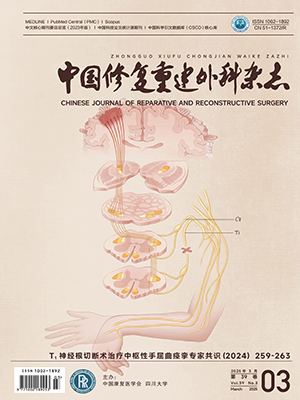【Abstract】 Objective To evaluate the effectiveness of artifical humeral head replacement in treatment of complicated
fractures of the proximal humerus. Method Between January 2005 and January 2011, 18 patients with proximal humerus
fracture were treated with artifical humeral head replacement. There were 8 males and 10 females with a mean age of 71 years (range, 52-84 years). Fractures were caused by falling in 11 cases, by traffic accident in 3 cases, and by bruise in 4 cases. The time between injury and admission was 2 hours to 3 days (mean, 1.5 days). According to Neer classification, 8 cases had three-part fracture, 7 four-part fracture, and 3 cleavage fracture of humeral head; 5 cases complicated by shoulder joint subluxation, 2 cases by femoral fracture, 1 case by radial fracture, and 11 cases by osteoporosis. All the patients were treated with modular cemented prostheses. Results The operation time was 60-180 minutes with an average of 80 minutes; the blood loss was 100-400 mL with an average of 200 mL. All incisions healed by first intention without infection or neurovascular injury. Sixteen patients were followed up 3 years on average (range, 1-6 years). No loosening, dislocation of prothesis or heterotopic ossification occurred. According to the Neer scores, the results were excellent in 5 cases, good in 8 cases, moderate in 2 cases, and poor in 1 case at 1 year after operation. The excellent and good rate was 81.2%. Conclusion Artificial humeral head replacement is a good therapy for patients with complicated fractures of the proximal humerus, especially for elderly patients.
Citation: WAN Yongxian,XU Lili,LU Xiaobo,ZHANG Zhongjie,GE Jianhua,CHEN Ge,TAN Meiyun.. EFFECTIVENESS ANALYSIS OF ARTIFICIAL HUMERAL HEAD REPLACEMENT FOR 18 CASES OFCOMPLICATED FRACTURES OF THE PROXIMAL HUMERUS. Chinese Journal of Reparative and Reconstructive Surgery, 2012, 26(2): 205-207. doi: Copy
Copyright © the editorial department of Chinese Journal of Reparative and Reconstructive Surgery of West China Medical Publisher. All rights reserved




